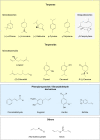Essential Oils as Multicomponent Mixtures and Their Potential for Human Health and Well-Being
- PMID: 36091825
- PMCID: PMC9449585
- DOI: 10.3389/fphar.2022.956541
Essential Oils as Multicomponent Mixtures and Their Potential for Human Health and Well-Being
Abstract
Essential oils (EOs) and their individual volatile organic constituents have been an inherent part of our civilization for thousands of years. They are widely used as fragrances in perfumes and cosmetics and contribute to a healthy diet, but also act as active ingredients of pharmaceutical products. Their antibacterial, antiviral, and anti-inflammatory properties have qualified EOs early on for both, the causal and symptomatic therapy of a number of diseases, but also for prevention. Obtained from natural, mostly plant materials, EOs constitute a typical example of a multicomponent mixture (more than one constituent substances, MOCS) with up to several hundreds of individual compounds, which in a sophisticated composition make up the property of a particular complete EO. The integrative use of EOs as MOCS will play a major role in human and veterinary medicine now and in the future and is already widely used in some cases, e.g., in aromatherapy for the treatment of psychosomatic complaints, for inhalation in the treatment of respiratory diseases, or topically administered to manage adverse skin diseases. The diversity of molecules with different functionalities exhibits a broad range of multiple physical and chemical properties, which are the base of their multi-target activity as opposed to single isolated compounds. Whether and how such a broad-spectrum effect is reflected in natural mixtures and which kind of pharmacological potential they provide will be considered in the context of ONE Health in more detail in this review.
Keywords: antibiotic resistance; essentail oils; integrative medicine; multicomponent mixtures; phytotherapy.
Copyright © 2022 Bunse, Daniels, Gründemann, Heilmann, Kammerer, Keusgen, Lindequist, Melzig, Morlock, Schulz, Schweiggert, Simon, Stintzing and Wink.
Conflict of interest statement
Authors MB, DK, and FS are employed by WALA Heilmittel GmbH; Germany and author HS acts as consultant (Consulting & Project Management for Medicinal & Aromatic Plants, Germany). The remaining authors declare that the research was conducted in the absence of any commercial or financial relationships that could be construed as a potential conflict of interest.
Figures




References
-
- Agarwal V. (2018). Complementary and Alternative Medicine Provider Knowledge Discourse on Holistic Health. Front. Commun. 3. 10.3389/fcomm.2018.00015 10.3389/fcomm.2018.00015 | Google Scholar - DOI - DOI
-
- Agatonovic-Kustrin S., Morton D. W. (2018). “Essential Oils and Cognitive Performance,” in Front. Nat. Produc.. Editor Atta-ur-Rahman (Sharjah: Bentham Science Publishers; ), 91–118. 10.2174/9781681087252118040005 10.2174/9781681087252118040005 | Google Scholar - DOI - DOI
-
- Ahmad A., Elisha I. L., van Vuuren S., Viljoen A. (2021). Volatile Phenolics: A Comprehensive Review of the Anti-infective Properties of an Important Class of Essential Oil Constituents. Phytochemistry 190, 112864. 10.1016/j.phytochem.2021.112864 PubMed Abstract | 10.1016/j.phytochem.2021.112864 | Google Scholar - DOI - DOI - PubMed
-
- Alshehri F. A. (2018). The Use of Mouthwash Containing Essential Oils (LISTERINE®) to Improve Oral Health: A Systematic Review. Saudi Dent. J. 30, 2–6. 10.1016/j.sdentj.2017.12.004 PubMed Abstract | 10.1016/j.sdentj.2017.12.004 | Google Scholar - DOI - DOI - PMC - PubMed
-
- Angelucci F. L., Silva V. V., Dal Pizzol C., Spir L. G., Praes C. E., Maibach H. (2014). Physiological Effect of Olfactory Stimuli Inhalation in Humans: an Overview. Int. J. Cosmet. Sci. 36, 117–123. 10.1111/ics.12096 PubMed Abstract | 10.1111/ics.12096 | Google Scholar - DOI - DOI - PubMed
Publication types
LinkOut - more resources
Full Text Sources

